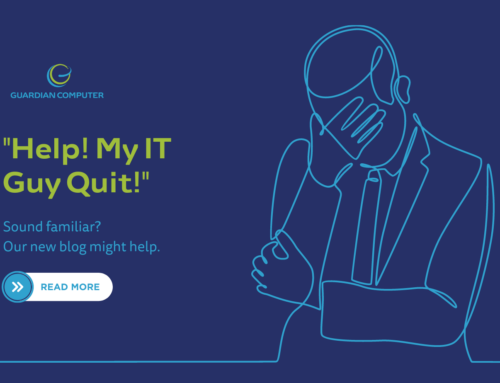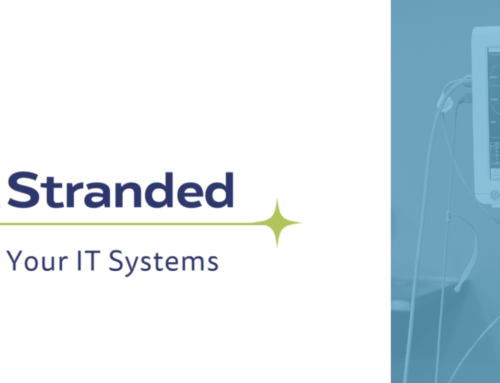Every business is concerned with minimizing expenses, but most don’t consider the true cost of network downtime. The cost of network downtime is the total cost of lost productivity, lost revenue, recovery costs, and intangible costs associated with downtime.
With so many other costs and concerns competing for your attention, it is all too easy for technology to fall to the bottom of the list. Maintaining employees, property upkeep, or any of the million other expenses that affect your business can feel more urgent—not to mention, you may have a better grasp on their solutions.
However, technology malfunctions like network downtime impact both productivity and revenue, while also incurring additional costs. If you’re trying to lower your business expenses, investing in quality technology and IT support will reduce your long-term costs.
If you find yourself wondering if investing in network technology, monitoring, and support is worth it for your business, you might want to weigh the cost of network downtime before planning your yearly budget. Keep reading to learn exactly what network downtime is, what it costs, what causes it, and how to prevent it.
What Is Network Downtime?
Your organization’s computer network is what controls interactions between the many devices and digital platforms that help run your business, including desktops, laptops, phones, smart appliances, company websites or servers, and more. Your network allows these devices and platforms to communicate with one another and access the internet.
Network downtime occurs when this digital network shuts down or becomes unavailable for use. Downtime can be either planned or unplanned.
When your IT team needs to make important technology updates, they may have to turn off your network temporarily. By planning ahead, your IT team can schedule the outage during a time that works best for your organization, such as after business hours.
When we talk about the consequences and cost of network downtime, we are discussing unplanned network outages. Unplanned network downtime can not only be a financial drain on your business, but also indicate potentially serious issues for your IT, such as a cyberattack.
The Real Cost of Network Downtime
When your digital network slows or goes down, there can be serious consequences for your business. Employees can’t access the tools or information they need to get their work done. Your team, stakeholders, and customers aren’t able to communicate. You may have to shut your entire office down for the day, if not longer.
The bottom line is that in the digital age, when your network goes down, so does your business.
Data from Gartner indicates that the average cost of network downtime for businesses is $5,600 per minute. This can vary greatly from one company to another, but there are many formulas available to calculate your unique cost of network downtime.
In the end, these calculations all come down to the sum of your losses and costs associated with a downtime incident. To calculate the total cost of network downtime, add the losses to both productivity and revenue, as well as your recovery costs and intangible costs.
Losses in Revenue and Productivity
Lost revenue is often the biggest cost of network downtime. When systems fail, they impact your company’s ability to carry out its services and earn money.
How much profit does your company make on average per hour? For every hour of downtime, you lose out on that potential profit.
There are also intangible costs related to your profitability to consider, such as the potential loss of current customers, loss of reputation and future sales, or drop in stock price.
Directly related to your loss in revenue is your loss of productivity. When a network failure occurs, it often impacts your personnel’s ability to perform their jobs. This not only results in a loss in profit during the hours your network is down, but also the cost of paying your employees during time they cannot work efficiently or at all.
Similarly, there are intangible costs related to productivity you must take into account. If employees can’t do anything while the network is down, their work and project deadlines will have to be moved around. This can cause missed deadlines, project delays, customer dissatisfaction, and all-around confusion that your organization must spend even more time and energy addressing.
Recovery and Intangible Costs
Recovering from network downtime comes with its own set of costs. To get your network up and running again, you may need to pay for replacement parts or repair services.
Once your network is running, you might have to pay for employee overtime to catch up on work and meet deadlines. If the outage resulted in data loss, there may be data recovery costs as well. An outage can also cause supply chain delays and related fees.
There are also a number of unexpected, intangible costs that can arise when a network goes down. Although they are harder to anticipate, they are nonetheless important to consider when weighing the potential cost of network downtime.
Intangible costs include those related to revenue and productivity, such as missed deadlines, project delays, loss of customers, loss of reputation and future sales, and drop in stock price. They can also include public relations costs if your business needs to recover its reputation or legal fees if your downtime resulted in a breach of contract, compliance violation, or lost or stolen data.
Top 3 Causes of Network Downtime
To avoid network downtime, you should understand what causes it in the first place. There are 3 major causes of network downtime to look out for in your organization.
1. Human Error
Human error is a common culprit for tech problems. It can cost you network downtime, among other issues.
Common mistakes can lead to network downtime, including:
- Failure to regularly update software applications or server hardware.
- Improper software installs on your business devices.
- Accidentally unplugging or detaching power plugs for key network devices, such as routers or desktop computers.
2. Equipment Failure
Equipment failure is another common cause of network downtime. This can be the result of low-quality technology or improper care and maintenance.
It’s possible for server hardware—even recently upgraded server hardware—to shut down when overheated. Technology can get overheated without constant air conditioning to cool the equipment. Interruptions from a power source can also result in network disruption.
3. Lack of Cybersecurity
A lack of cybersecurity is not only a concern for the security of your network, but also the security of any information system or sensitive data that passes through your organization. Employee ignorance, outdated or nonexistent security software, or the absence of a robust, proactive cybersecurity approach could mean huge losses for your business—beyond simply the cost of network downtime.
Without proper cybersecurity, you leave your organization open to phishing, viruses, malware, ransomware, and other major security threats to businesses. All it takes is one wrong move from an employee to open your network up to a cybercriminal.
If you are not carefully monitoring your network and systems, a hacker could remain in your network undetected for days, if not weeks or months. The longer a criminal spends in your network, the more access they can gain and damage they can cause.
Once inside, a cybercriminal could take down your network. But downtime will be the least of your worries. The hacker could be stealing your sensitive information or even holding it ransom.
Network Downtime Solutions and Proactive Prevention
Fortunately, the cost of network downtime can be prevented! There are several proactive measures you can take to avoid or minimize your downtime.
1. Professional Equipment Maintenance and Lifecycle Management by a Reputable Managed Services Provider
The best way to prevent equipment failure is to take extra care when selecting, handling, and replacing your hardware and software. Purchase quality equipment and keep it well-maintained so it will perform its best and your organization can operate efficiently. At the same time, regularly review your inventory of equipment and replace older tech before it slows down your operations or breaks, resulting in unplanned downtime.
If it doesn’t make sense for your budget to upgrade certain equipment, consider simply keeping your software up to date whenever possible. Staying on top of software updates can optimize your technology’s performance and minimize your chances of network downtime.
Without an IT background, it can be difficult to know how to balance quality with cost when purchasing equipment and determining when to replace it. A reputable managed services provider will have the latest industry knowledge and firsthand experience required to help your business select the right equipment for the long run—without overspending on unneeded bells and whistles.
2. Boosting Cybersecurity
A rule of thumb for cybersecurity is that there is always room for more! Whether it’s purchasing security software or training your staff, cybersecurity is an investment that continues to yield benefits for your business.
There are more ways than one to improve your security, allowing you to choose solutions that fit your needs and budget. Using antivirus and anti-malware software is a great place to start. Look for highly rated security programs that have the features you’re looking for. If you already have this software, make sure there are protocols in place to keep it up to date.
Data encryption is another critical security tool. It turns your sensitive information into gibberish for anyone attempting to view it without the key. Even if a hacker gains access to your information, it is useless without the encryption key.
In addition to cybersecurity measures that prevent attacks, it is important to keep an eye out for issues and prepare for the possibility of a successful attack. Continuous monitoring of your network and systems allows you to spot potential problems right away. This can help stop hackers before they can access or get them out as soon as possible. You should also back up your data and develop a disaster recovery plan so you can act quickly and efficiently if you are attacked.
If you’re not sure what’s best for your business, consult with an IT expert to make the most of your cybersecurity budget.
3. Due Diligence Assessment
An IT due diligence assessment will evaluate the effectiveness of your network and systems. Even if you have an IT team, their evaluations will be inherently biased. Getting a third-party assessment can help you better understand the technology needs of your business.
A thorough due diligence assessment should review your IT infrastructure, systems, personnel, and processes. It can identify areas where your organization could improve, as well as provide a plan for how to make those improvements. If there are redundancies or cost-saving opportunities, a good due diligence assessment will reveal them.
4. Employee Training
Employees are the first line of cyber defense for your organization. Human error is a big problem, but a solvable one.
Invest in periodic IT and cybersecurity training for all employees. Everyone at your organization should know how to operate the technology they need to perform their jobs. Not only will this reduce equipment failures, but also it should improve productivity and efficiency.
Your employees should also understand cybersecurity basics, such as creating strong passwords, keeping antivirus and anti-malware software up to date, and knowing how to spot phishing, ransomware, or other cyberattacks. As more and more employees switch to remote work, they should also know what precautions to take while using public Wi-Fi and other cybersecurity best practices for travelers and remote workers.
For bigger IT and cybersecurity issues, make sure your IT team or IT provider is available to field employee questions, concerns, and issues.
Avoid the Cost of Network Downtime with Guardian Computer
If you’re concerned about the cost of network downtime, seek assistance from the highly trained professionals at Guardian Computer. With decades of combined cross-industry experience, as well as a commitment to customer service and growing alongside changing technology, we are ready to meet your IT challenges head on.
We want to help you make the most of your current technology, while also preparing you for the future. Technology should serve your needs and support your bottom line, not drain your time and resources. Our expert recommendations and responsive IT support turn technology into an asset instead of an enemy.
Contact us today to learn how we can help you with your next IT project or provide for all your IT and cybersecurity needs!






